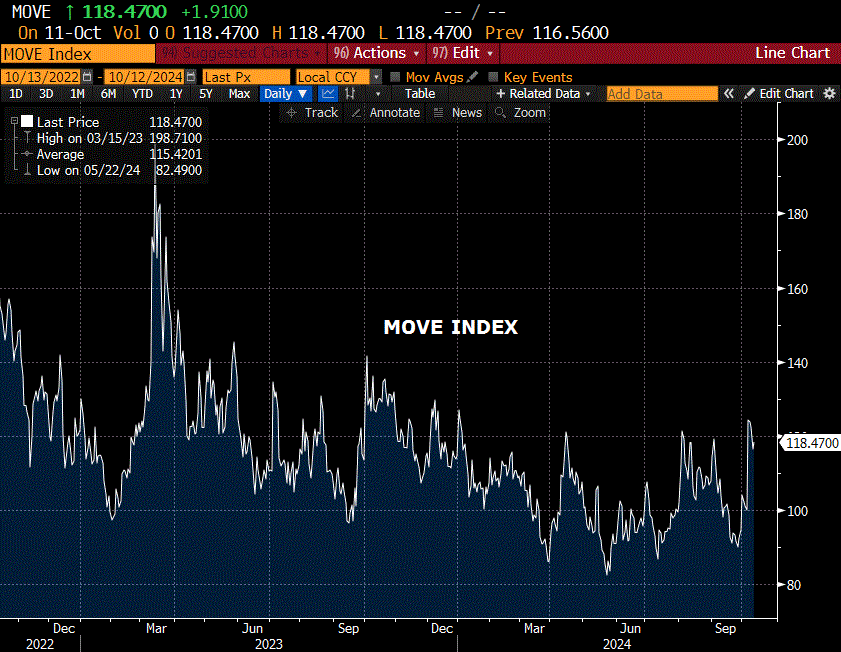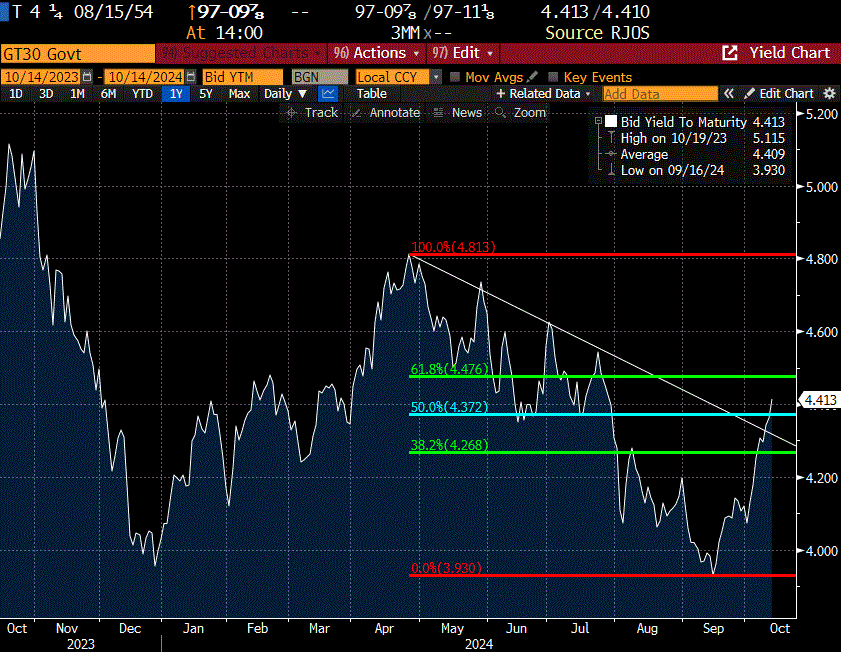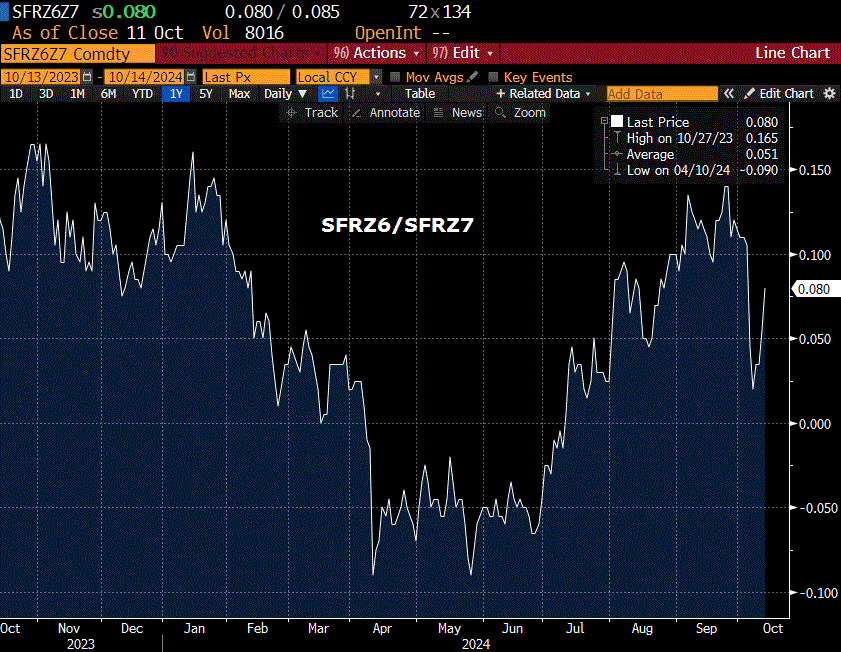Really Awesome
October 13, 2024 -Weekly comment
**************************************
One of Bloomberg’s top headlines on its website Sunday is:
Retail Traders Embrace Market Turbulence With Bets on Volatility
Here’s a quote:
“We’re starting to get into unprecedented territory here,” says Akshay Aravindan, a 25-year-old software engineer at Microsoft who trades early in the morning before work starts. “This market is going to be really awesome to adjust your positions based on how intense vol gets.”
This article is about VIX and related ETFs. But I’m right with Akshay. Things are about to get “really awesome” though I might not exactly phrase it that way.
With all the new technology and AI out there, I still feel the way you really LEARN about something is by making your OWN mistakes. As Elle King sings in ‘The Let Go’, “…expensive lessons are always the best to know.”
Anyway, I worked on the CME floor ages ago for Chase. Our desk had an error, only discovered the next day. We had traded the wrong contract, something like Red Dec vs Green Dec Eurodollars. The strip at the time didn’t go past greens. In those days, it wasn’t all that uncommon to realize a problem the next day; after phone tapes had been checked, physical tickets pulled, see what cleared. No 24 hour trading; you got out next day. Of course, that morning the calendar spread was against us. It was my job to exit. So I figured I would leg out of it. Brilliant. Sold out the near contract in a weak market and hoped to buy the deferred contract cheaper. You all know what happened next. I chased the back contract up by more than a few basis points to close out. Then, I had to go upstairs and confess the larger than expected loss at the end of the day. The spread had moved such, even before I pulled the trigger on the first leg, that the near contract was printing down on the day and the deferred was positive. I explained that I hadn’t seen that before. Led to one of my rules: “Always leg from the illiquid side first.” (You were probably thinking: “Hit the bid in the SPREAD.” That’s a good one too).
I’m not mentioning this story in relation to VIX, but more as a cautionary tale with respect to interest rate and curve volatility, which I think will catch a lot of traders offsides in the upcoming several months. My themes are 1) trim position size because there are likely to be “really awesome” i.e. random moves. 2) even after the flattening post-employment and hints of a slow-play ease cycle, the curve is likely to steepen.
Below is the MOVE index. After Druckenmiller said he is modestly short bonds due to the fiscal situation, I thought I should post a vol chart on US, but then concluded that things could easily go haywire across the entire curve. The MOVE looks elevated, but I think there is more to come. If I recall correctly, Harley Bassman’s (MOVE inventor) loose rule is to buy at 80, sell at 120. This calendar year that’s pretty much been the range. I think risk is to the upside. [if I recall correctly, MOVE is weighted 40% 2yr and 20% each, 5, 10 and 30yr]

The next chart I featured last week and put out related posts on Linked-In and X. I thought the long-bond would probably chop around the midpoint of this calendar year’s range (4.37%). At futures settle on Friday I marked it at 4.38%, but the chart shows a higher yield of 4.41. (And YZ, you’ll notice that I DID include your suggested trendline that has now been broken!)
Though I favor higher long-bond yields, this isn’t so much about direction, but rather movement. Bill Fleckenstein was interviewed on the Thoughtful Money podcast and echoed Druckenmiller, saying that the relatively sharp yield increase of 50 bps in tens and bonds since the 50 bp cut at the FOMC meeting is a possible signal of a revolt. Again, he was tentative in terms of timing, but it feels to me as if sentiment has changed.

The final chart below is a SOFR calendar spread, SFRZ6/Z7. There’s nothing particularly compelling about this specific spread, but on my summary of weekly changes (shown at bottom) I always mark the first three one-year SOFR calendars. Note that Z4/Z5 was DOWN 6.5 bps from -90 to -96.5 (continued weakness in Z4 as easing projections are pared back). Z5/Z6 was DOWN 6 from +4.0 to -2.0. But Z6/Z7 was +3.5 from 4.5 to +8.0. Contracts from Z7 back are successively weaker. It’s another possible clue that market participants aren’t anxious to own longer dated paper, perhaps due to inflation concerns, but also due to fiscal irresponsibility.
Last week I highlighted the front-end puke, as stronger than expected payrolls caused reassessment of easing speed. That continued to some degree over the past week as Fed officials tamped down on easing hopes. However, despite tempered rate-cut prospects, 2/10 rallied last week (same dynamic as Z6/Z7) from 5.3 to 13.3 bps. We’ve entered an environment where specific parts of the curve respond to different macro concerns.
I’ve always liked the “Gotta hunch? Bet a bunch!” slogan. But going into the election, it’s probably best to keep risk close to home.

| 10/4/2024 | 10/11/2024 | chg | ||
| UST 2Y | 392.8 | 393.9 | 1.1 | |
| UST 5Y | 381.3 | 387.7 | 6.4 | |
| UST 10Y | 397.7 | 407.1 | 9.4 | |
| UST 30Y | 426.8 | 438.1 | 11.3 | |
| GERM 2Y | 220.3 | 223.5 | 3.2 | |
| GERM 10Y | 221.0 | 226.5 | 5.5 | |
| JPN 20Y | 165.6 | 173.4 | 7.8 | |
| CHINA 10Y | 221.0 | 214.7 | -6.3 | |
| SOFR Z4/Z5 | -90.0 | -96.5 | -6.5 | |
| SOFR Z5/Z6 | 4.0 | -2.0 | -6.0 | |
| SOFR Z6/Z7 | 4.5 | 8.0 | 3.5 | |
| EUR | 109.77 | 109.52 | -0.25 | |
| CRUDE (CLX4) | 74.38 | 75.56 | 1.18 | |
| SPX | 5751.07 | 5815.03 | 63.96 | 1.1% |
| VIX | 19.21 | 20.46 | 1.25 | |

